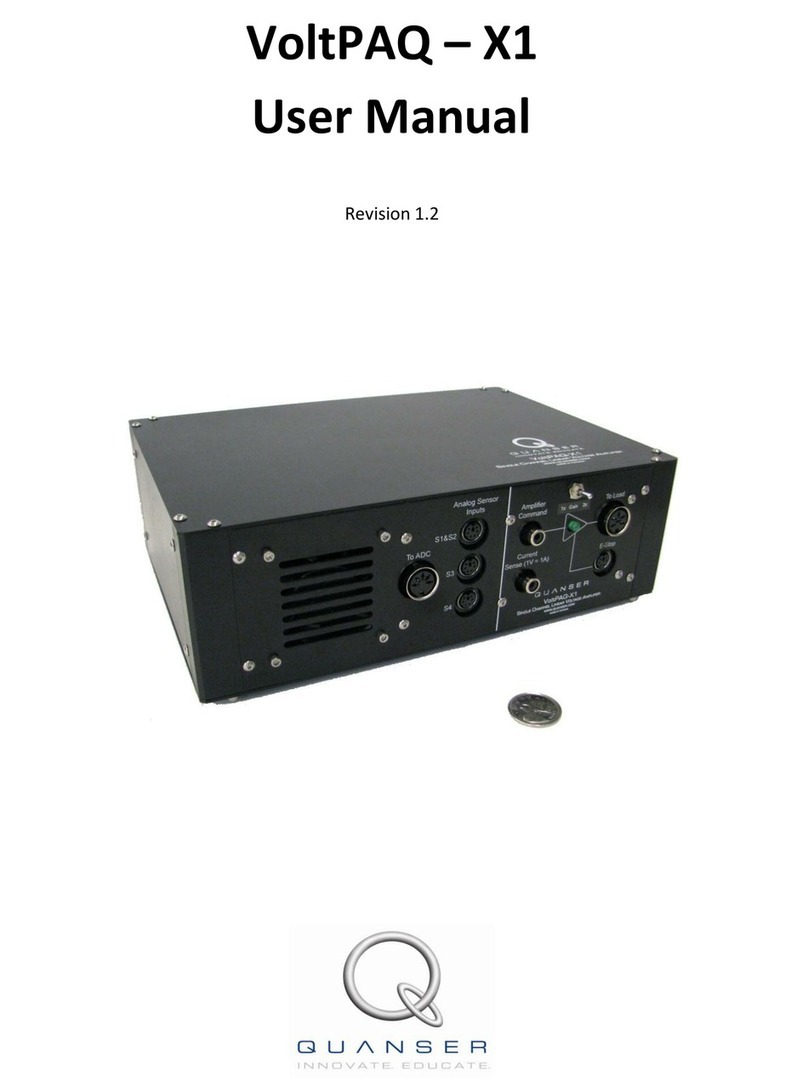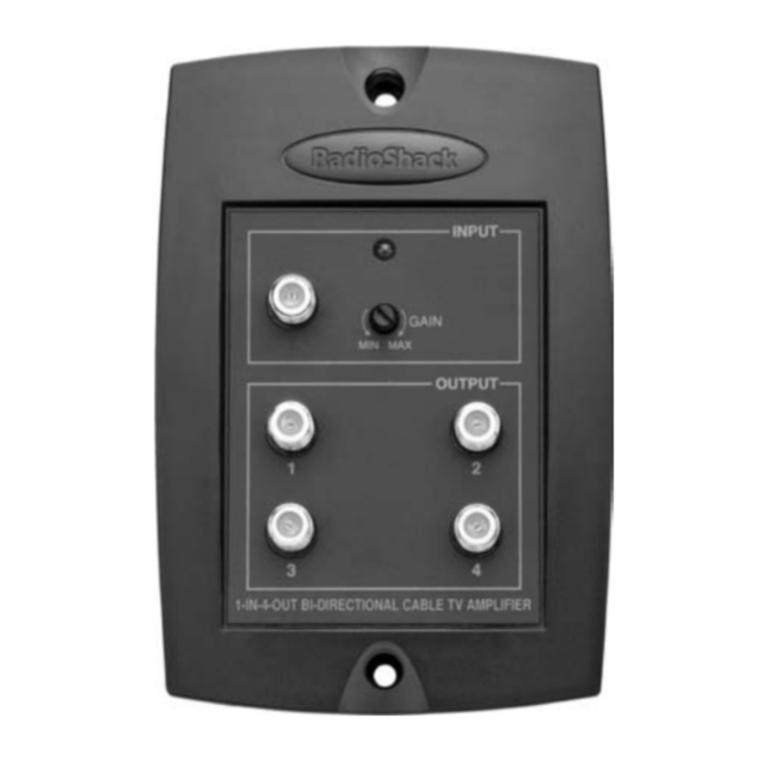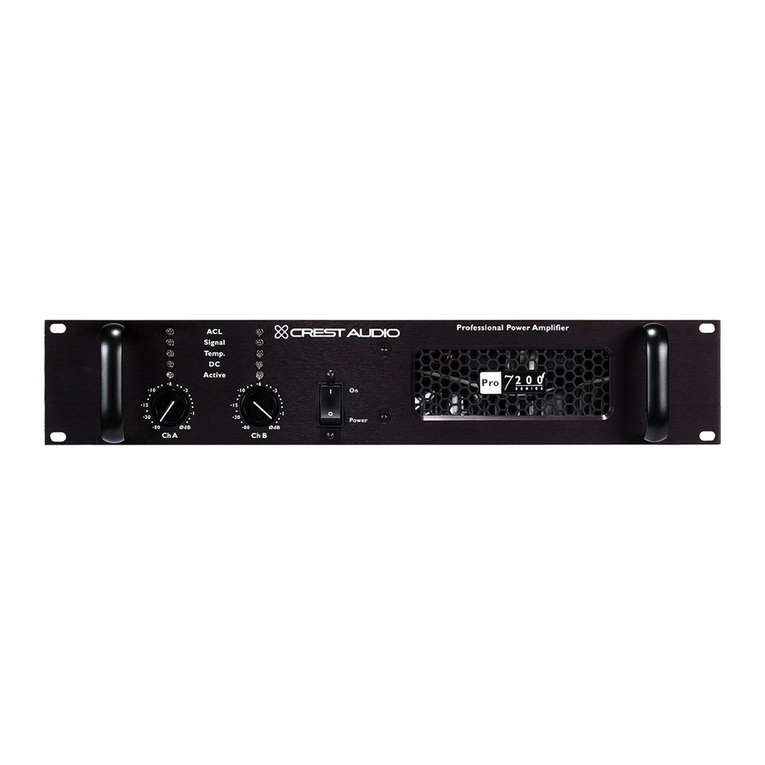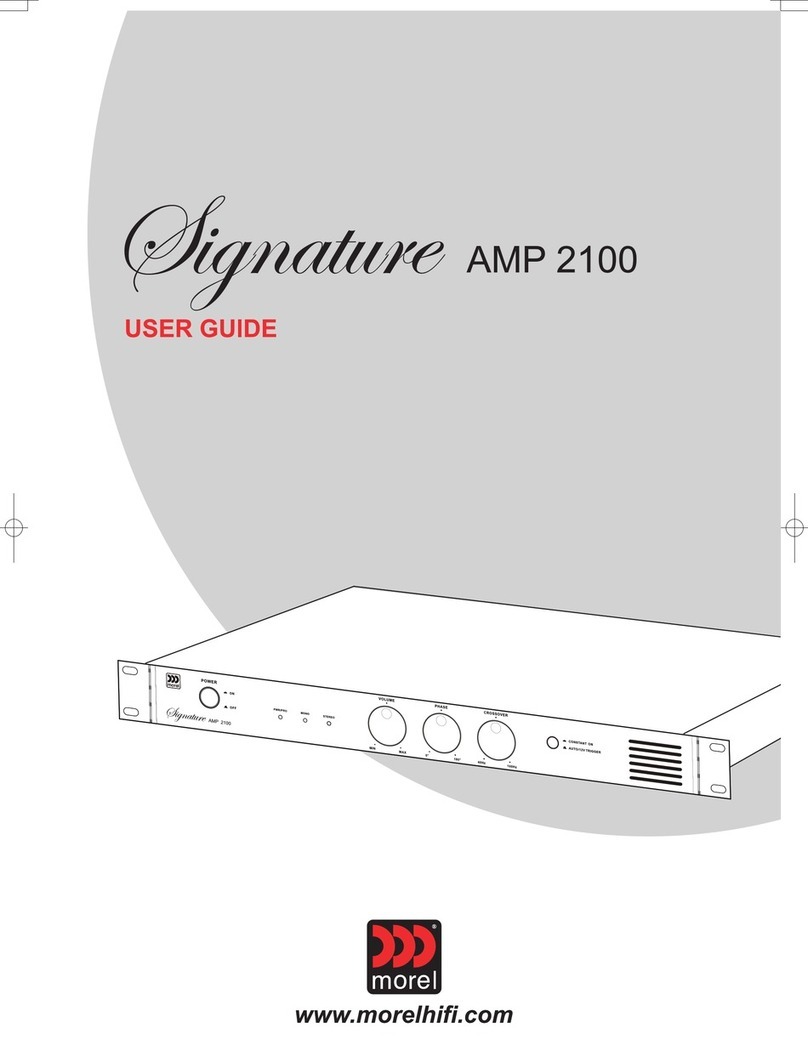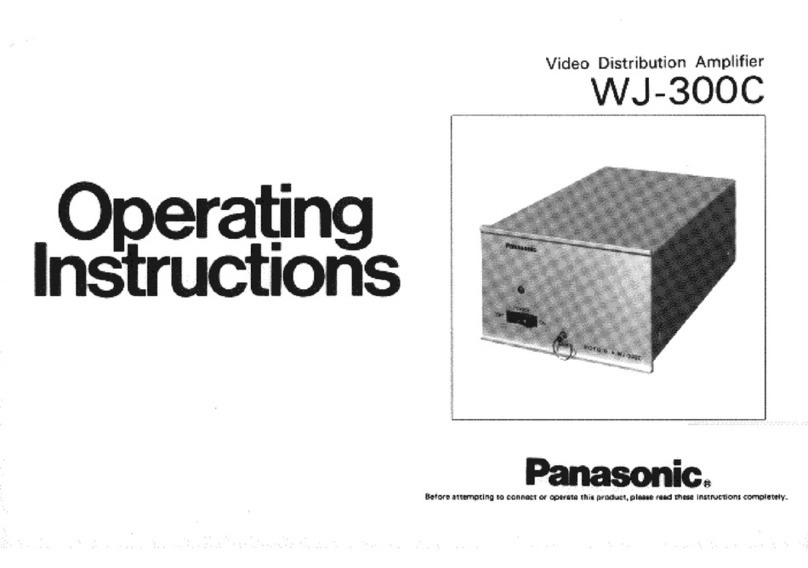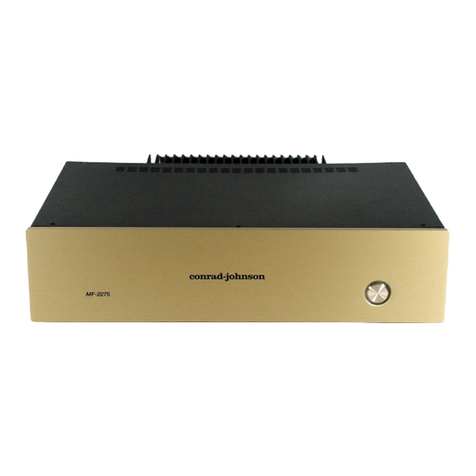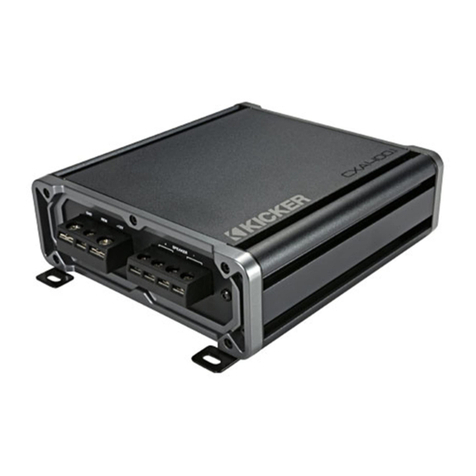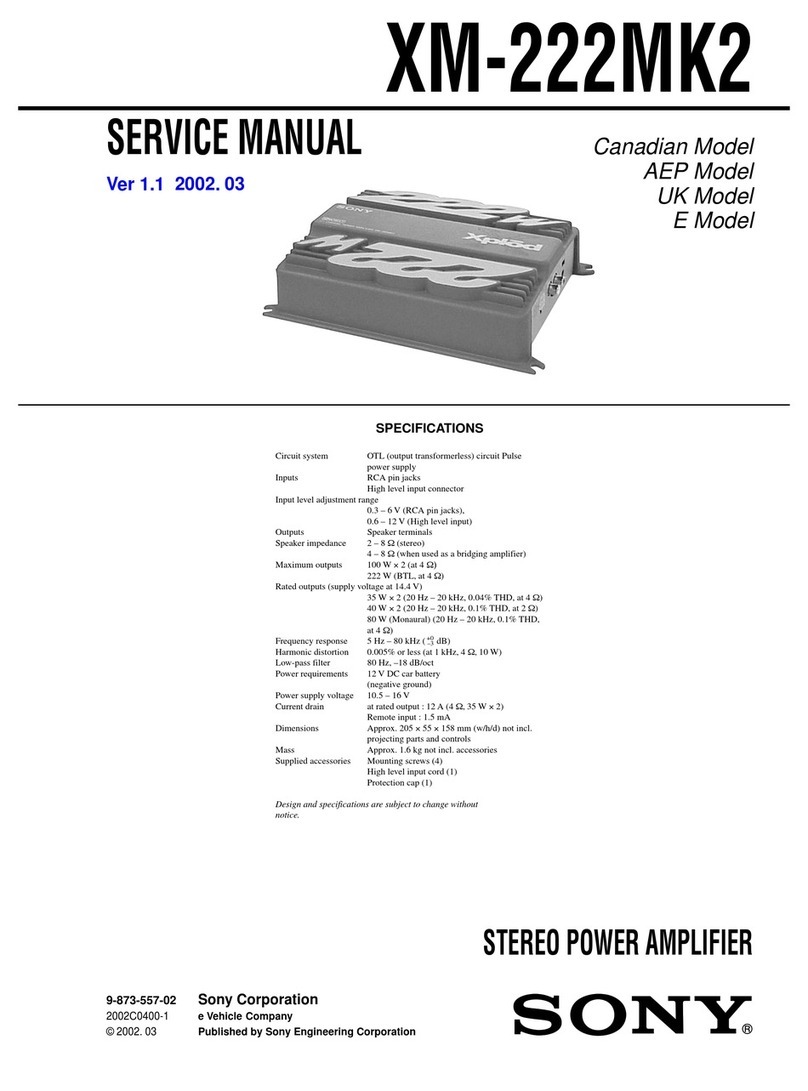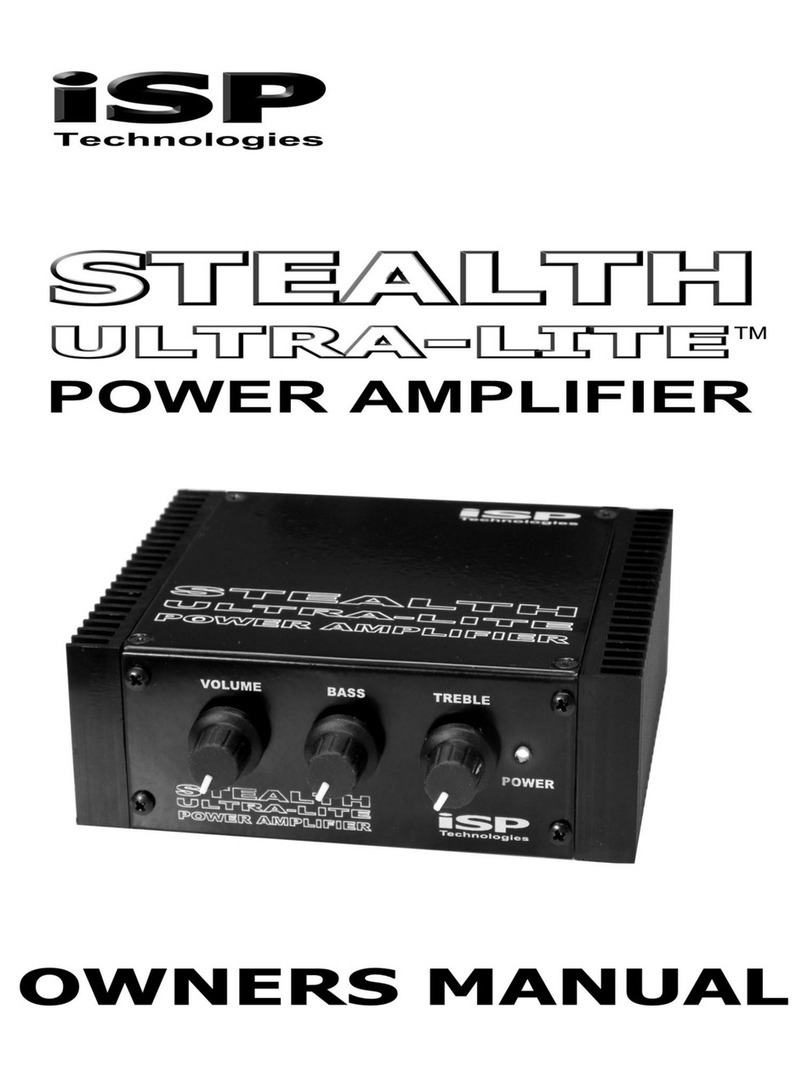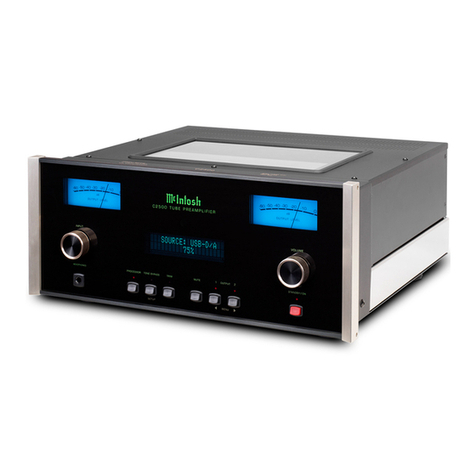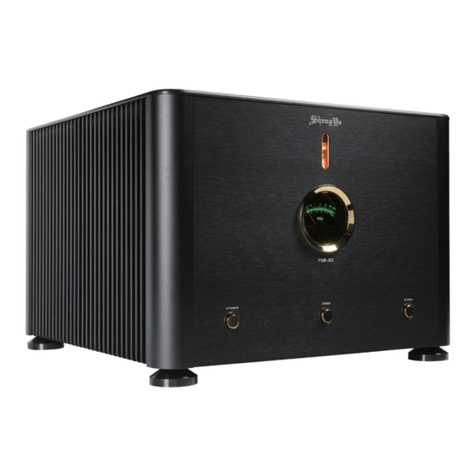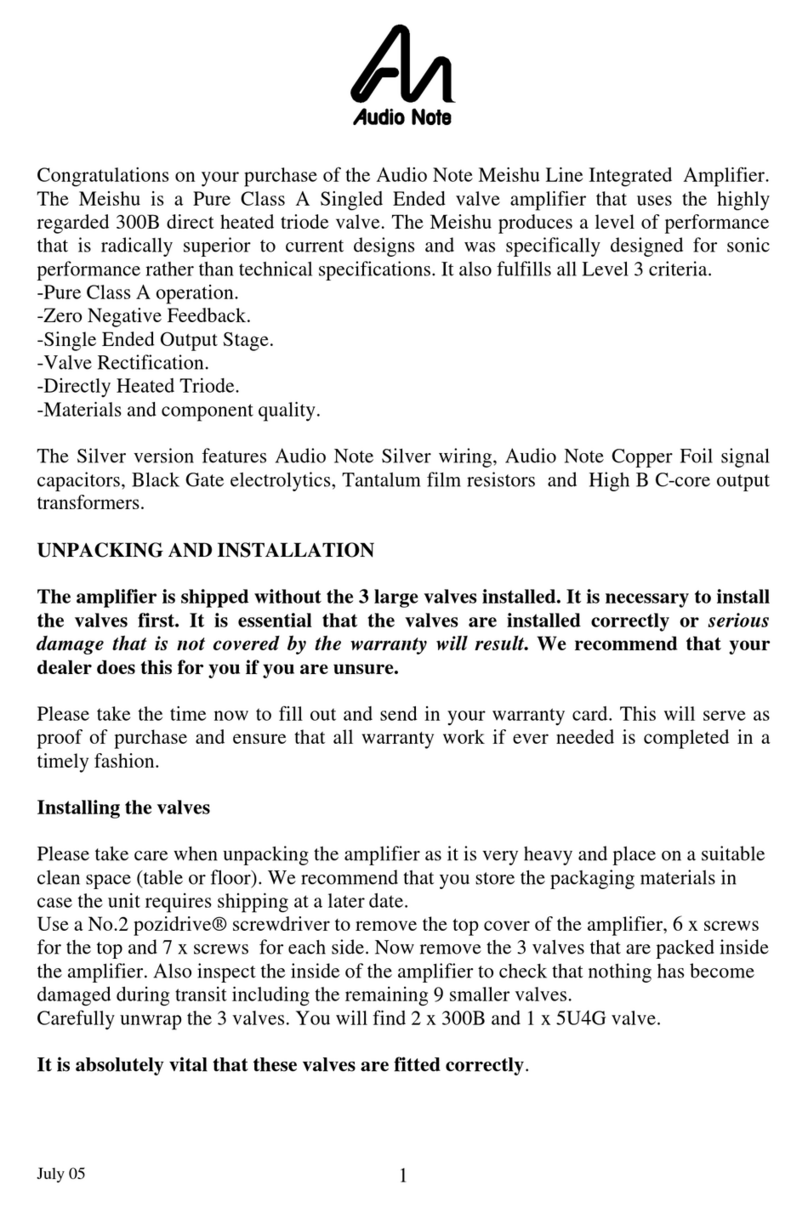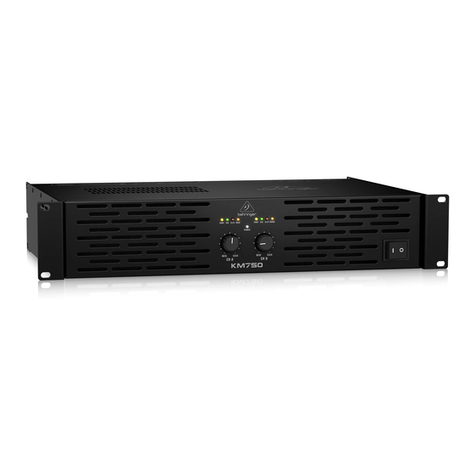McCormack DNA-750 User manual

DNA-750
Mono
Power Amplifier
Beyond
Your
Expectations
Within
Your Reach
McCORMACK
AUDIO CORPORTATION OF VIRGINIA

DNA-750 Owner’s Manual 1
Thank you for purchasing a McCormack Audio DNA-750 Power Drive. This amplifier was
hand crafted with top quality, highly reliable component parts. We are confident that you
will be well satisfied with its sonic performance and find pleasure in its functional beauty.
Before you enjoy these experiences, however, please take a few minutes to read this
Owner's Manual and acquaint yourself with the instructions for optimal operation. This will
ensure your listening pleasure today, and for many years to come.

DNA-750 Owner’s Manual 2
INSTALLATION
We recommend that you save the box and packing materials. Store them in a dry
environment. It is best to use the original package should you need to transport your
DNA-750 Power Drive.
Place your DNA-750 Power Drive on a stable surface in a location which allows adequate
ventilation. If it is sitting on a carpet, use either a flat board or Tip Toes underneath to
keep the ventilation slots unobstructed. Do not locate it in direct sunlight or expose it to
extremely high temperatures (above 70 degrees centigrade/154 degrees Fahrenheit).
Allow at least four inches of open space on each side, and six inches of open space both
above and behind. Do not block the ventilation slots on the top or bottom, or the heat
sinks on each side.
All DNA-750 Power Drives sold in the United States are configured for operation on a
60Hz ac power line producing between 108 and 126 volts. Export versions of the DNA-
750 will have the correct operating voltage and frequency clearly marked on the back
panel of the unit, near the ac power cord. In all cases, the actual line voltage should be
within + 5/-10% of the nominal rated voltage.
Electromagnetic Interference (EMI)
Considerable care has been taken in the design of the DNA-750 to minimize its
susceptibility to radio frequency interference and other forms of EMI. Choice of materials,
physical layout, grounding practice, and power supply design have all been specified with
a view to reducing the impact of electromagnetic fields on the performance of this unit. At
the same time, however, our primary goal is the accurate reproduction of recorded music
in the normal home environment, and we have elected not to compromise this objective
by the application of heavy-handed RFI filters, or by using grounding practices that
reduce RFI at the expense of degraded audio performance. We find that the approach we
have taken has worked extremely well, resulting in only rare instances of EMI problems
which could be treated locally as needed, rather than compromising the performance of
our product in the 99.9% of installations where EMI is not a problem.
Care in installation can often avoid EMI induced problems. The following practices should
generally be observed in any application, and will be especially important where EMI may
be a problem.
Interconnect cables should be kept as short as possible (3 meters or less), and shielded
cable should be used (cable which has two center conductors, and a separate external
shield connected at only one end).
Physical location and cable “dress” can be an important factor in minimizing hum pickup.
The installation should situate the preamplifier well away from the power amplifier, and
power (ac mains) cords should be dressed to remain at least 4" (100mm) away from
input/output cables.

DNA-750 Owner’s Manual 3
CONNECTIONS
The DNA-750 Power Drive provides both standard RCA phono jacks and XLRs for input
connectors and 5-way binding posts for output connectors.
Position the DNA-750 Power Drive as close as possible to its final installation location,
while allowing access to the backpanel connectors.
1. Install an inter-connect cable from the main output of your preamplifier to the
input RCA jacks or to the XLR balanced input connectors located on the rear
panel. Be certain the plugs are fully inserted, making a tight connection. Always
install the interconnect cables first when connecting an amplifier, and remove
them last when disconnecting an amplifier. This will prevent potential damage to
the loudspeakers in case the power supply has not fully discharged.
IMPORTANT NOTE: use only ONE of the two connectors–XLR or RCA. DO
NOT make connections to both.
2. Check again to be certain the DNA-750Power Drive's power switch is turned off.
3. Install suitable speaker cables from your speaker's input connectors to the output
connectors located on either side of the rear panel (two sets of connectors are
provided for bi-wired applications).** When finished, recheck that all connections
are correct and tight.
**In a stereo system, the two channels should be connected in correct "relative
phase". This means that when the same signal is applied to both channels, the
right and left channels speaker diaphragms will move synchronously -in and out
together. Terminals on speakers are usually coded -one designated "C",
"ground", "-" or black, the other designated "+" or red. "In phase" connection of the
speakers can normally be achieved by taking care to connect the wire from the "+"
amplifier terminal to the red or "+" coded terminal on each speaker, and
connecting the "-" terminal to the black or "-" coded terminal on each speaker. In
phase connection of the speakers can be readily ascertained by ear. Listen to a
recording of a solo vocalist (use a mono recording if available). With the speakers
in phase the voice should be clearly focused between the two speakers. With the
speakers connected out of phase, the voice will be diffused, with no identifiable
source. Relative phase may be reversed by switching the "+" and "-" leads at one
speaker only.
WARNING: DO NOT GROUND EITHER THE POSITIVE OR NEGATIVE
CONNECTIONS. DO NOT CONNECT TO COMMON GROUND SWITCHING
SYSTEMS.
4. Check that the power switch on the front panel is in the off position. Plug the AC
power cord into the DNA-750 Power Drive, then plug the other end into an
appropriate wall outlet.
5. Move the DNA-750 Power Drive to its permanent location. Check that your
system's volume control is turned down all the way. Turn on the front panel
power switch. Your DNA-750 Power Drive is ready for operation.
Questions
If you have questions about the installation or function of your DNA-750 do not hesitate to
call Customer Service at (703) 698-8581.

DNA-750 Owner’s Manual 4
GETTING THE MOST FROM YOUR DNA-750
In a system of high quality components, the McCormack DNA-750 Power Drive offers a
remarkable level of sophistication and refinement in music reproduction. To get the best
performance out of any audio system, there are a number of important details that must
be attended to.
Absolute Phase
Musical notes are heard through the ear’s response to waves of alternating rise and fall of
air pressure. Musical transients are almost exclusively positive: that is, the initial effect is
a rise in pressure. The ear is capable of distinguishing these positive transients from the
musically unnatural alternative of a negative transient (an initial fall in air pressure). In
your stereo system, these transients are created by your loudspeakers. If the speakers
respond to musical transients by first moving out, they are creating a rise in pressure, and
the system is said to be phase correct. If they respond by moving in, they create a fall in
pressure and the system is said to be phase inverting. Each component in the stereo
system either preserves the phase of the incoming signal, and is said to be phase correct,
or inverts the phase and is said to be phase inverting. It is unimportant whether an
individual component is phase correct or phase inverting, as long as the system as a
whole is phase correct. This will be the case if the number of phase inversions is even (or
zero).
The DNA-750 is phase correct. If your system has an odd number of inversions, (for
example, if you have a phase inverting preamplifier in your system) then you must add
one phase inversion. This is conveniently done by reversing the positive and negative
connections to your speakers (be sure to reverse both channels). If you are not sure
about the phase of every piece in your system, you can establish correct absolute phase
by careful listening. When the system is in correct phase, transients will be noticeably
cleaner and more sharply defined. The effect is especially apparent on plucked string
sounds. A final warning -not all recordings are phase correct (including some “audiophile”
recordings), so listen to several before concluding your investigation of absolute phase.
The Importance of Wires
Interconnect and speaker wires are an important element in your stereo system.
Interconnects are available which will permit a reference quality system to blossom and
fulfill its promise of musical reality. Others will strangle the system to the point where it
becomes little better than average. To complicate matters, our experience suggests that
the choice of interconnects will be system dependent -those that are top ranked on one
system may be a poor choice for a different system. Consult your McCormack Audio
dealer for recommendations for your specific system.
Performance Tip
Warm up the DNA-750 Power Drive before serious listening: The sonic performance
improves noticeably as the unit warms up. The midrange becomes more lucid, the highs
smoother, and the soundstage expands. The warm up period can be expected to last
about fifteen minutes.

DNA-750 Owner’s Manual 5
SPECIFICATIONS
Output Power: 650 watts into 8 ohms, and 1000 watts into 4 ohms, from 20 Hz to 20 kHz
at 1% THD.
Input Impedance: 13kOhms
Input Sensitivity: 3.1Vrms
Voltage Gain: 27.4 dB
Frequency Response: -3dB @ .5 Hz, 65 kHz
Signal-to-Noise: 112 dB
Harmonic Distortion (10 watts, 1 KHz, 8 ohm load): .1%
Signal Polarity ("Absolute Phase"): Non-Inverting
Power Requirements (117V/60HZ): 0.7 Amps /84 Watts @ idle
6.8Amps/ 820 Watts @ clipping (8 ohms)
Dimensions: 19" W x 6 7/8" H x 15 D"
Weight: 61 lbs.
FUSES
AC MAINS FUSE—The ac mains fuse is located in a fuse holder near the ac power cord
receptacle on the back of the amplifier. The correct fuse type and value depend on the ac
mains voltage that the amplifier is wired for. The correct values are:
For 100/120V ac mains –3AG 12Amp, slow-blow
For 220/240V ac mains –3AG 7amp, slow-blow
Replace this fuse only with the correct type and value. If the fuse blows again immediately
or after a short time, do not continue replacing it, as a fault condition exists which must be
corrected.
B+/B-POWER SUPPLY "RAIL" FUSES --These are the four fast-blow fuses mounted on
the bottom of the circuit board inside the chassis. The fuse clips(located near each of the
main heat sinks) accommodate two 3AG type fuses per channel (7Amp). To replace
these, first unplug the AC power cord from the DNA-750 Power Drive, then remove the
screws holding the bottom cover in place and lift it off. Replace these fuses only with the
same value and type (7Amp, fast-blow).

DNA-750 Owner’s Manual 6
TROUBLESHOOTING:
Problem: Amplifier does not operate; indicator light does not light at all.
Check AC power cord connections (both ends). Check the AC outlet for power. If the AC
connections are proper and the outlet is live, check the AC line fuse, replacing if
necessary. Re-test the amplifier. If the AC line fuse blows again, contact your dealer for
servicing information.
Problem: Amplifier does not operate; indicator light comes on.
Check the condition of the B+/B-rail fuses. Replace any blown fuses. Turn on the
amplifier and check operation. IF the B+/B-rail fuses have blown again, contact your
dealer for servicing information.
Problem: Amplifier turns on normally, but no sound is produced.
Check all connections carefully. Check your preamplifier's input, mute, and volume
settings.
Service
If your DNA-750 requires service, repack it using the original box and packing material
and ship to the Service Department address below. Boxes and packing materials can be
purchased through our service department if you no longer have yours. Include with the
unit a note describing the problem you are having in as much detail as possible. It is
especially important for our technician to know if the problem is intermittent. If you want
an estimate of cost for out of warranty service, be sure to request it in this note. Be aware
that requesting an estimate will delay service to your unit, as we will have to contact you
for approval before commencing service.
Service Department
McCormack Audio Corporation of Virginia
2733 Merrilee Drive
Fairfax, VA 22031
by phone at 703-573-9665, or by fax at 703-560-5360.
Table of contents
Other McCormack Amplifier manuals


